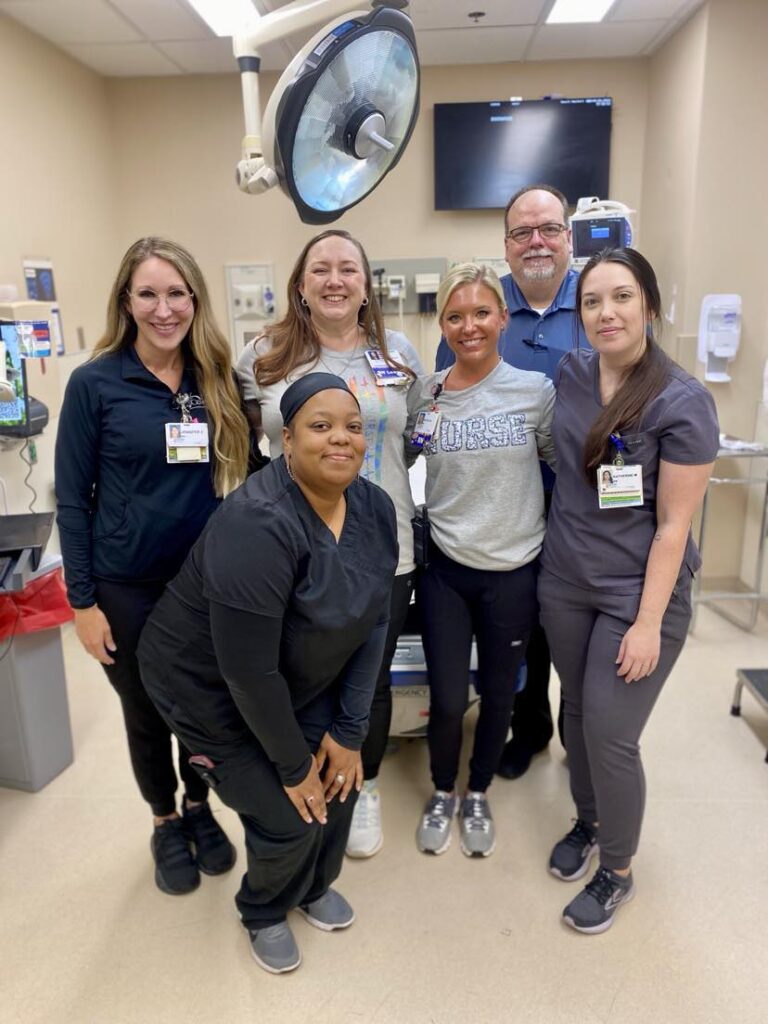Excellent Emergency Care at Methodist Medical Center

Lacy Sherrill lives on her family farm in Morgan County with her husband and six children. She also cares for her aging father who lives nearby. When she had a sudden blood clot that caused her to lose oxygen to her brain, she seized and had to go to the emergency room. Fortunately, she was stabilized by the expert team at Methodist Medical Center and is doing well today.
Sherrill had suffered from an ankle fracture in February 2024 that was still bothering her months later, even after she got out of her cast. “It was the Monday after Mother’s Day; I woke up and told my husband I don’t feel well,” Sherrill recalls. “Before we could decide what to do, I began having a seizure. My husband got me to Methodist Medical Center and by then I was unconscious. They treated me and there’s no question they saved my life.”
Emergency Care When Needed Most

Sherrill’s husband, Joe, helped his wife during the seizure. When he noticed her breathing was abnormal and that she had gurgling and drainage in her mouth and nose, he brought her to the hospital.
Shanda Gruse, RN, is a shift manager in the Methodist Medical Center emergency department. Gruse reports that Sherrill was not responsive upon her arrival, and the team of ER nurses and doctors moved quickly to intervene. Gruse says, “They made sure she had a clear airway and that she was stable, because her blood oxygen level was quite low, and her heart rate was elevated. The time she got to our door to the time she was intubated (to help her breathe) was approximately 18 minutes.”
Sherrill says that everyone they interacted with was just excellent. “They were extremely kind and caring. I have no lasting deficits. They did a great job and I felt cared for, and everyone at my bedside paid careful attention to me and all they were doing. I would highly recommend this hospital for emergency treatment.”
Risk of a Blood Clot
“I didn’t know I had developed a DVT (deep vein thrombosis) in my leg,” says Sherrill. Deep vein thrombosis occurs when a blood clot forms in one or more of the deep veins in the body, often in the legs. Deep vein thrombosis can cause leg pain or swelling. Sometimes there are no noticeable symptoms. In Sherrill’s case, doctors later confirmed that a blood clot had formed in her leg and moved to her lungs, making it difficult to breathe and cutting off oxygen supply to her brain.
The instance of forming a clot after an ankle fracture is less than 10 percent. However, there are several conditions that can increase these odds; patients that do form clots often occur within the first 90 days after the fracture according to recent literature from the National Institutes of Health.
Sherrill was eventually transferred to another facility for a higher level of care, but she didn’t need as much intervention as initially thought because of the quick treatment at Methodist.
“I had a slow healing break in the ankle, so I had done a cast, and then a walking boot. I did physical therapy and took blood thinners, but not a strong enough dose. It didn’t occur to me the pain in my leg could have been a blood clot. I had just gotten back to walking out of my boot.”
Sherrill speaks of her family, to whom she returned to live her normal life. Their ages are 22, 17 (twins), 12, 13 and 9. Sherrill was a nurse for 27 years before transitioning to care for her father. Her mother helps her train donkeys for hiking companions, and they also raise cattle on a 100-acre farm. She is grateful to the healthcare professionals who intervened that day and helped her return to her quality of life.
“I want to express my heart-felt thanks for the care they showed me and the attention they showed my husband. The mortality rate of having a pulmonary embolism (PE) at home is high – they saved my life.”
Pulmonary embolisms occur when there is a sudden blockage in your pulmonary arteries, the blood vessels that send blood to your lungs, and they can be fatal. In some people, the clot can cause a neurological response; in most people this can look like stroke or heart attack symptoms, but in some it can present as seizure or seizure-like activity. Seizures themselves can cause the aspiration and low oxygen levels. Because all the systems in the body are regulated by the brain, this is what could have caused Sherrill’s symptoms.

Signs of a Pulmonary Embolism
The signs of a pulmonary embolism can vary from person to person but can include unexplained shortness of breath, chest pain, cough, coughing up blood and fainting.
Gruse says, “Typical treatment for a PE or DVT is anticoagulation therapy, which can be injectable or oral medicines. This medication is typically started in the hospital and may continue at home. Patients can then follow up with their primary care provider or a specialist, depending on the severity and location of the clot. The outcome in this situation could have been fatal had the team not worked as quickly as we did.”
Gruse shares, “Our team at Methodist has some of the best professionals I have worked with anywhere, and I have worked in several different systems across the country. The doctors are smart, caring, calm, and work with the nurses to make sure we give the best possible care for the patients we see. Our nurses love serving this community.”
She adds, “Most of our team lives here or at least close by, so it truly is like taking care of a family member when each patient comes to us. Due to the nature of our work, communication is essential and our team in the ER is amazing! I would like to mention the rest of the staff that were here that day: Dr. Chase Ranson; Don Branam, PharmD; Jennifer Canter, RN; Christy P’Simer, RN; Christin Marcum, RN; Kayla Alcorn, RN; Katherine Miley, RN; Leslie Jannotte, RN; and Lori Crocheron. All these individuals and I comprised Ms. Sherrills’ team that day, and each person was essential in their role to get her treated quickly so she could be with us here today.”
At Methodist, the staff take pride in their jobs. Gruse says, “Some days are better than others, but every day we come to work to put our patients first and treat the patients like family.”
Sherrill’s advice to others is to not ignore leg pain or lingering symptoms from an injury. “It didn’t register that pain in my leg eight weeks after an injury could be something serious like a blood clot. Tell your doctor if you have this issue and take it seriously!”
For information on Methodist’s Services, please visit mmcoakridge.com.

Covenant Health
Headquartered in Knoxville, Tennessee, Covenant Health is a not-for-profit, community-owned, healthcare enterprise committed to providing the right care at the right time and place. Covenant Health is the area’s largest employer and has more than 11,000 compassionate caregivers, expert clinicians, and dedicated employees and volunteers.


